|
|
Brûleur

|
|
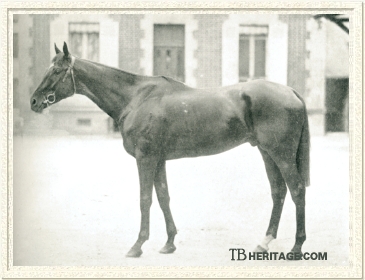 |
|
|
Brûleur proved a savior for the French Thoroughbred after that country's breeding industry was ravaged during World War I. In fact, Brûleur was one of the last really top class horses to appear on the French turf before the start of hostilities. Foaled in 1910, Brûleur concluded his career after the 1914 season and became a link to the future as his son, KSAR, became the first outstanding performer on French racecourses after the war was over.
Brûleur was bred by Evremond Saint-Alary and born at his Haras de Saint-Pair du Mont near Calvados, Normandy. Saint-Alary had previously bred and raced champion Omnium II and his champion daughter,Kizil Kourgan. The former was a formidable stayer, winning the Prix du Jockey Club two editions of the 2400 meter Prix du Conseil Municipal, the Prix Rainbow and the Prix Gladiateur. The latter, a daughter of Omnium II, was victorious in the classic Prix de Diane and Grand Prix de Paris. Another daughter of Omnium II, was Basse Terre.
Basse Terre traced in the direct female line to 1856 One Thousand Guineas victress Manganese, and her second dam, the Doncaster filly Thora, was a multiple stakes winner in Great Britain. Thora's daughter Bijou, by St. Gatien, was sold to Evremond Saint-Alary, and for him produced Basse Terre. She proved a moderate winner on the track, accounting for the Prix Vanteaux, Prix de la Société de la Encouragement, and Prix Roxelaine.
At stud, Basse Terrre proved exceptional; her 1907 filly Basse Pointe, became the heroine of the Prix du Conseil Municipal, Prix Vermeille, and Grand Prix de Deauville. Upon her retirement to the broodmare paddocks at Haras de Saint-Pair du Mont, Basse Pointe also became a good matron, producing Bonny Boy, winner in England of the Ascot Stakes and Great Ebor Handicap. She was also the second dam of Balmoral and Porphyros, both winners of the Prix du Conseil Municipal.
Normally, any breeder would be delighted to have a mare produce one horse of the extreme quality of Basse Pointe. However, Basse Terre was not done, for Brûleur came along three years after Basse Pointe. Saint-Alary was fond of the blood of Dollar, a French-bred son of English Derby winner The Flying Dutchman. Dollar, a decent performer on the turf, proved a highly successful stallion, leading the French sire list in 1878 and siring five French classic winners. So enamored was he of Dollar, Saint-Alary had no qualms about inbreeding to him. In the spring of 1909, he mated Basse Terre to Chouberski, a descendant of Dollar in the direct male line. This gave the resultant foal, Brûleur, a 5 x 4 in-breeding to Dollar.
Chouberski proved a winner of his only start and during an abbreviated stud career, sired nothing of any exceptional quality except Brûleur. He was third on the French sire list in 1913 through Brûleur's expolits. Chouberski proved a better sire of broodmares, his daughters producing Prix de l'Arc winners Kantara and Biribi, in addition to the aforementioned Porphyros.
Brûleur on the Turf
Brûleur was a difficult animal to train. He did not like his races too close together, and he was possessed of an unpredictable, and sometimes volatile, temperament. Consequently, Brûleur was unraced as a juvenile. He made the first start of his career in the Prix Juigne, run over a distance of ten furlongs. In a field of seventeen, Brûleur finished a creditable fourth, beaten by a shade over three lengths. Just a week later, Brûleur improved to be beaten only a neck in the Prix Hocquart. Given a rest of three weeks, Brûleur made his third start a winning one in the Prix des Lilas. This was followed by another win in the Prix La Rochette ten days later.
In the space of a little over a month, Brûleur had made four starts and won twice. But that hectic schedule caught up with him when he was sent to the post for the premier French three-year-old classic, the Prix du Jockey Club, run in the middle of June at the beautiful Chantilly racecourse. Another packed field of seventeen lined up, and the winner was Dagor, an exceptional colt by Flying Fox, in fact, the last French champion sired by the expatriated English Triple Crown winner. Brûleur was third, beaten a total of three lengths.
A fortnight after his run in the Prix du Jockey Club, Brûleur went off the favorite in the historic Grand Prix de Paris, run over 1-7/8 miles. For a horse blessed with the staying genes of Brûleur, this race was tailor made. His victory, belied by the winning margin of just a length, was remarkably easy.
Brûleur could not reproduce that form a week later in the 1-5/8 mile Prix du Président de la République, as he finished a dull sixth of nine. Given a two month break, Brûleur won a minor race at Chantilly in preparation for the French St. Leger, the Prix Royal-Oak , contested over the same 1-7/8 mile distance as the Grand Prix de Paris. Brûleur won by two lengths.
Brûleur closed out his first season of competition with a lackluster effort in the Prix du Conseil Municipal. He was victorious in only four of eleven starts, but his victories in the Grand Prix de Paris and Prix Royal-Oak established him as a stayer of the highest calibre.
Brûleur was out only three times at four for a single victory. He was second to Ecouen by a neck in the 2-3/8 mile Prix Edgard Gillois, won the 2-3/4 mile Prix La Rochette over Dagor, and then finished a disappointing fourth to Aleppo in the Ascot Gold Cup in England. Within only a few weeks of this race, continental Europe, with its complex web of alliances and which had been a smoldering tinderbox since the assassination of Archduke Franz Ferdinand at the end of June by a Serbian national, erupted into World War. Brûleur's racing career was abruptly ended.
Brûleur in the Stud
Brûleur was immediately retired to his birthplace at Haras de Saint-Pair du Mont. Despite the war raging in the fields of France, some French thoroughbred farms were able to continue breeding on a reduced scale. Haras de Saint-Pair du Mont was fortunate to not be affected by the ravages of the war, thus enabling Brûleur to enjoy a stud career which ultimately became long and highly successful. He sired three winners of the Prix de l'Arc de Triomphe, four winners of the Prix du Jockey Club, four winners of the Prix du Cadran, two winners of the Prix Royal-Oak, and one each of the Grand Prix de Paris and English Oaks. In all, Brûleur sired six classic winners--Ksar, Hotweed, Pot au Feu, Priori, Madrigal, and Brulette. He led the French sire list three times, in 1921, 1924, and 1929, and was in the top ten on six other occasions.
Brûleur's temper became quite savage when he went to stud, often after servicing a mare he would become uncontrollable and dangerous to approach for several hours afterward. For a time, Brûleur had a female groom who was the only person who could safely handle him on a consistent basis. The racing merits of his offspring made all the trouble worthwhile.
Without a doubt, the best of Brûleur's get, both as a racetrack performer and as a sire, was KSAR, a chestnut colt foaled in 1918. His dam was the brilliant racemare Kizil Kourgan. The mare had not enjoyed much good fortune in the breeding ranks, having produced nothing of any special significance prior to the birth of Ksar. She was in fact an aged nineteen when he was foaled. Ksar was inbred 3 x 2 to Omnium II, he being the broodmare sire of both Brûleur and Kizil Kourgan.
|

Ksar
| |
Despite his splendid pedigree, KSAR was not an attractive individual, being described, as "awkwardly put together with large clodhopper feet, and poor action." His breeder Saint-Alary decided to sell him as a yearling, and was quite surprised when the colt fetched 150,000 francs. He became the property of another pillar of French breeding, Edmond Blanc.
|
KSAR proved a boon for his new owner. He captured one of two starts at two, and then blossomed into the best horse of his generation at three, taking the Prix Hocquart, Prix Lupin, Prix du Jockey Club, Prix Royal-Oak, and the Prix de l'Arc de Triomphe. He continued his domination as a four-year-old, capturing the Prix des Sablons, Prix du Cadran, Prix du Prince d'Orange, and a second edition of the Arc de Triomphe.
At stud, KSAR led the French sire list twice and sired Tourbillon and Thor, each victorious in the French Derby (with Tourbillon going onto a spectacular stud career in his own right); Ukrania, victress in the Prix de Diane; and Le Ksar, winner of the English Two Thousand Guineas. KSAR was also a broodmare sire of some importance, is daughters producing French classic winners Le Pacha, Stratonice, and Garbosa Brûleur, a champion filly in Brazil.
|
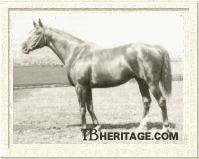
Pot au Feu
| |
Foaled in 1921 from the Spearmint mare Polly Peachum, it was alleged that POT AU FEU was not sired by Brûleur at all, but by the farm teaser. According to the tale, there were three mares waiting to be bred to Brûleur, which, with the horse's difficult temperament, proved a daunting task. The groom managed to get the first two mares successfully bred, but then came Polly Peachum's turn for her tryst with the fiery stallion. The groom supposedly decided to make his lot a bit easier--and no doubt safer--by having her covered by the teaser. This all would have had to be done with Haras de Saint-Pair du Mont farm staff being accomplices, an unlikely happening, but it made for a juicy tale considering the course of events in the career of Polly Peachum's resulting foal. |
POT AU FEU came up for sale as a yearling at Deauville and was knocked down to His Highness the Aga Khan, who was in the process of building a racing and breeding empire, which, by the 1930s would be one of the most powerful in Europe. For His Highness, POT AU FEU captured the Prix du Jockey Club and Prix du Prix du Président de la République. Whether the Aga Khan believed the story surrounding his classic-winning colt is a matter of conjecture. What is certain is that he promptly sold Pot au Feu when his racing days were over. POT AU FEU made an indifferent sire, eventually winding up at stud in Kentucky. For a time he stood at Coldstream Stud near Lexington, his fee being free to approved mares. His name lives on in pedigrees mainly through his daughter Dinner Horn, ancestress of such important performers as champion and Broodmare of the Year Primonetta; Kentucky Derby and Belmont Stakes winner Chateaugay; and Preakness and Belmont Stakes winner Little Current.
|
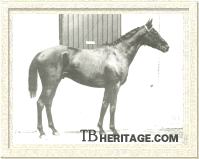
Priori
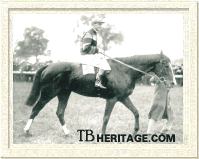
Madrigal
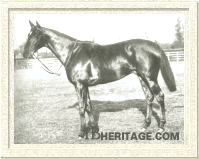
Hotweed
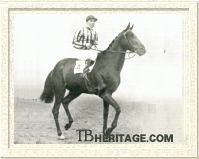
Brulette
| |
Brûleur's next classic winner was foaled in 1922, the bay colt PRIORI. He was produced from the St. Bris mare Primavista. Like his sire, Priori was an outstanding stayer, his victories including the Prix Royal-Oak, Prix du Cadran, as well as the Prix de l'Arc de Triomphe. He was also second in the Ascot Gold Cup. He did not make a mark as a stallion, perhaps because he inherited a good share of his sire's unstable temperament.
MADRIGAL, out of the Mordant mare La Maddaloun, was foaled in 1923, and was a winner of the Prix du Jockey Club. Madrigal stood at stud first in France and then was exported to Argentina, where he enjoyed considerable success. Among his stakes winners in Argentina were Superi, a winner of the Clasico Comparacion and El Guaso, winner of the Clasico Palermo. Madrigal's son, L'Oriflamme, become a leading sire in both Argentina and Uruguay. Madrigal's daughters produced many high class winners, including Pipote, a winner of the Gran Premio del Jockey Club, Argentina's version of the English Derby.
In the 1926 crop came HOTWEED. A bay colt out of Spearmint's daughter Seaweed, Hotweed was victorious in half of his twelve starts. His resume included tallies in the Prix du Jockey Club, the Grand Prix de Paris, Prix Cadran, Prix Hocquart, Prix Lupin, and Prix Gontaut-Biron, and second place finishes in the Prix de l'Arc de Triomphe and Ascot Gold Cup. He stood at stud for several seasons in France, Great Britain and the United States, and one of his colts, Pearlweed, was a winner of the Prix du Jockey Club.
Two years younger than Hotweed was his full sister BRULETTE, just as formidable a racetrack performer as her older sibling. During her racing career, Brulette won races in France and England. In France, she was victorious in the Prix du Cadran and Prix la Rochette. On excursions across the English Channel, she took the English Oaks at Epsom, the Jockey Club Cup and Goodwood Cup.
As a broodmare, much was expected of her, and in the short run, BRULETTE was something of a disappointment. She did produce a Press Gang filly named Croix de Feu, who was a winner in England of the Marcus Beresford Stakes, and her daughter Tropical Sun was placed in the Oaks. Her few sons were of no account as racers or at stud, with the exception of Stockade, who sired some decent winners in Australia. The daughters of Brulette bred on however, and over the next several generations, the family of Brulette has produced such standouts as Vaguely Noble, English and Irish Oaks heroine Diminuendo, European and American champion mare All Along, and the blisteringly fast Hedevar, famous in American racing lore as the "rabbit" for his more illustrious stablemate, dual classic winner Damascus.
|
SAMOS, foaled in 1932, was a bay filly resulting from Brûleur's union with Samya, by the French stallion Nimbus. She was victorious in the Prix de l'Arc de Triomphe and placed second in the Prix de Diane. She was champion three-year-old filly in France in 1935. As a broodmare, Samos was moderately successful, producing two stakes-placed runners and the stakes winner Marveil. One of her stakes-placed progeny, the filly Sakountala, became the dam of the Djebel colt Hugh Lupus, a champion in Ireland and England whose victories included the Irish Two Thousand Guineas, Champion Stakes, and Hardwicke Stakes.
|
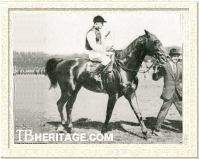
Tricard
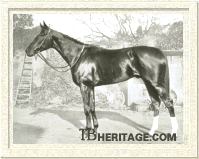
Palais Royal
| |
Brûleur sired many other top performers, notably TRICARD, winner of the Prix du Conseil Municipal; PALAIS ROYAL, winner of the Prix Hocquart; CREME BRULEE and POKER, each winners of the Park Hill Stakes in England; PEARLASH, winner of the Prix la Rochette; KISS CURL, victorious in the Prix Dollar; and FINGLAS, winner in England of the King Edward VII stakes and Queen Alexandra Stakes, second in the Ascot Gold Cup and third in the Arc de Triomphe.
Brûleur compiled an admirable record as a broodmare sire, and was among the leaders on that list for France twice. His daughter LIBERTAD produced Prix de Diane winner Lysistrata. Chaudiere , winner of the Prix du Cadran, was produced from Brûleur's daughter BOUILLOTTE. Hunter's Moon, by Foxhunter, was out of Brûleur's daughter PEARL OPAL, a half sister to the great French racemare Pearl Cap, the first of her sex to capture the Arc de Triomphe and herself the dam of a classic winner in English Derby winner Pearl Diver. Hunter's Moon captured the Prix Juigne, Prix la Rochette, and in England, the Cesarewitch Handicap. He wound up at stud in the United States, at Christopher Chenery's The Meadow Stud near Doswell, Virginia, later fabled as the birthplace of Secretariat. He proved a useful sire, but his best was undoubtedly Neji, a three-time steeplechase champion in the United States.
|
Brûleur died in 1936, aged 26. Though those who were in charge of his immediate care were probably not sorry to see the vicious old stallion finally go to his rest, the breeders of France lamented the death of the horse who had brought new life to the fortunes of the French Thoroughbred, so badly decimated during the years of the first World War.
--Elizabeth Martiniak
|
|
|
|

